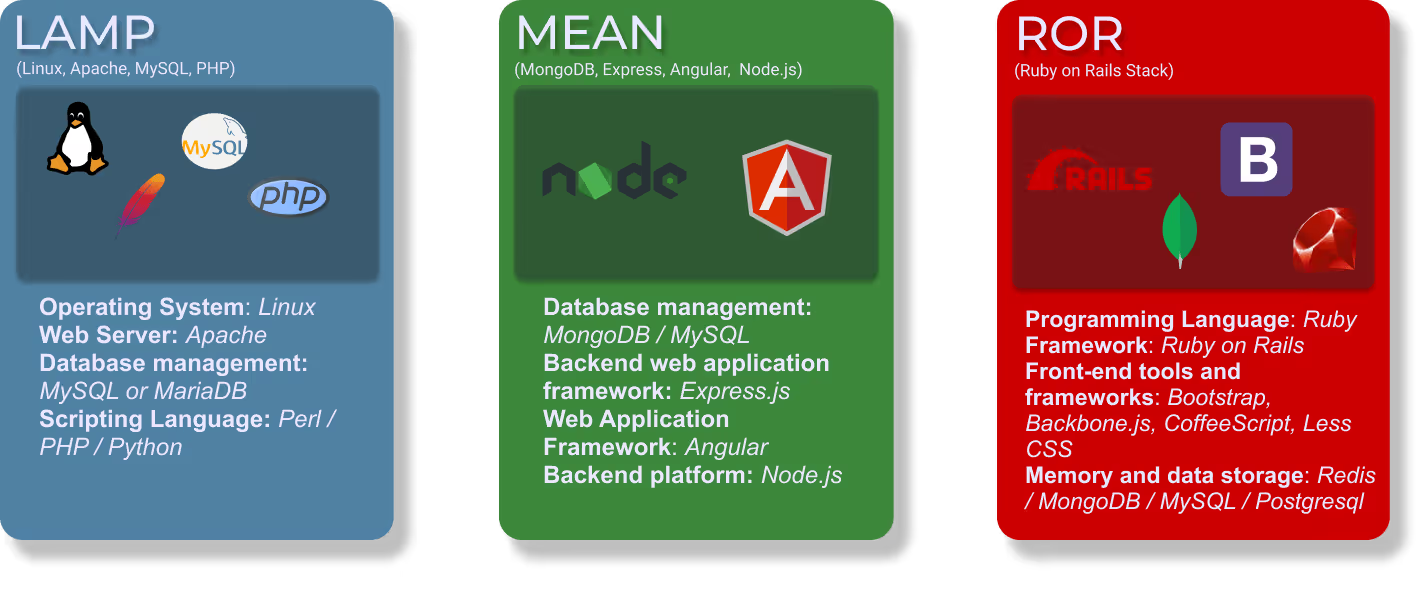Everyones trying to gain an advantage over the competition and with an estimated 12 million – 24 million eCommerce sites across the globe, it’s not easy to stand out in the competitive world of online retail.
One way eCommerce sites have been capturing their customer’s attention is by offering well-designed and highly personalized online shopping experiences.
In this article, we’ll look at what tools can help your website stand out to potential customers and the technologies that will help support the scalability and long-term growth of your company.
Whether you’re investigating options for a new project or evaluating an existing project, this article is meant to shorten your search and help make the evaluation process a little easier.
Your technology stack is the collection of programming languages, frameworks, and other technologies that power your online store. Your technology stack can be broken down into two main categories: front-end and backend.
The client-side or front end is the part of your website that is visible to the public; it's the interface customers see when they visit your online store. The main components you’ll use to shape and design the look of your website are HTML, CSS, and JS.
While the back end isn’t visible to end-users the same way the front end is, it’s equally as important, after all these are the technologies powering your front end. The back end allows developers to store and access data, as well as create complex business logic making your website dynamic. Three major components of your back end are server-side programming language, server, and database.
When it comes to choosing a server-side programming language for your project there are many factors to take into consideration including developer availability, avg. cost of talent, scalability, and performance.
PHP: Laravel, Symfony, Phalcon, Slim
Ruby: Ruby on Rails, Sinatra, Padrino
Python: Django, Flask, Pylons
You’ll need a way to store data and that’s where your database comes into play. Common databases include MySQL, PostgreSQL, MongoDB, DynamoDB, and Firebase Database
Lastly, you’ll need a server to handle requests from client’s some popular options include Apache and Nginx.

What could be considered the third component of your eCommerce technology stack are third party services and software that provide additional functionality to your online store. For example, working with a payment gateway to process payments online or improving customer experience through marketing automation software.
These tools not only save you development time, but they can also significantly improve your bottom line by saving you money and helping generate more sales.
Prisync is a competitor price tracking and monitoring software for eCommerce. Offering stock availability tracking, dynamic repricing automation, worldwide currency coverage, powerful reporting, email alerts, and a robust API for extensive automation. Prisync offers Shopify and Magento integrations.
Spark Shipping is dropshipping software that integrates with your existing E-commerce store to automate order fulfillment, provide dropshipping automation, and Amazon repricing. Automatically route orders to vendors, distributors, suppliers, or fulfillment centers. As orders come in Spark Shipping will intelligently send orders to the correct place. One of the great things about Spark Shipping is it works with all vendors including eBay, Amazon, BigCommerce, WooCommerce, Magento, and Shopify.
Speechly is a tool that enables developers real-time voice user interfaces that update as the user speaks. You can use Speechly to quickly create a voice-powered form or even to create a voice-powered shopping cart. Speechly integrates seamlessly with your current user interface to provide amazing voice-based user experiences.
Referral Candy helps eCommerce stores increase sales by getting shoppers to refer their friends. It’s an app that helps you accelerate word-of-mouth referrals through automation.
Thankbot is a great service for creating memorable experiences and wowing your customers. The service allows you to send handwritten, personalized thank-you notes at scale.
Competition in the eCommerce space has forced companies to look beyond creating basic cookie-cutter websites with a shopping cart, payment processing software, and a product catalog. In today’s highly competitive eCommerce marketplace you see companies focusing on user experience; taking the time to design unique handcrafted online shopping experiences for their customers.
At end of the day, your tech stack should align with your business strategy and support your short and long-term goals as a company. Finding the right technology for your business might take some experimentation but it’s a necessary step if you want your eCommerce business to succeed.
Subscribe to our blog and get the latest articles, insights, and industry updates delivered straight to your inbox